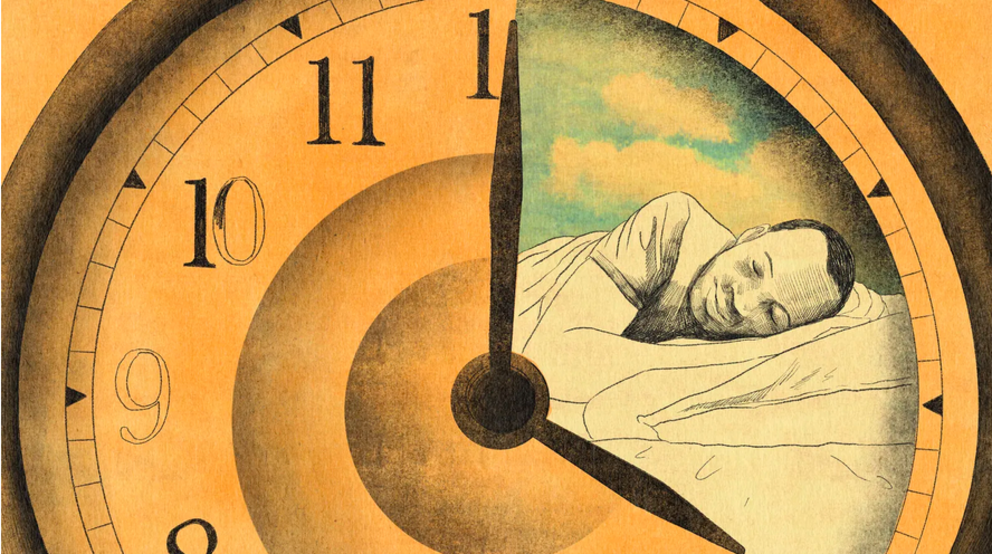What are the best lucid dreaming techniques?
Lucid dreaming holds a widespread appeal, but many people simply can't do it. So what do studies show are the best techniques?
I first heard about lucid dreaming as a teenager, and for a short while became fascinated with it. The idea of being conscious in your dreams, and even being able to direct and adapt them, holds an obvious appeal. Ever wanted to fly? Walk through walls? Meet a famous person? Anything could be possible in a lucid dream – in theory at least.
Lucid dreaming simply means a dream where you're aware that you're dreaming, while you are still asleep. There is of course a huge spectrum of what can occur in the dream within this definition – from a fleeting, passive awareness you are in a dream to taking full control of the dream and being able to direct it.
In research at sleep laboratories, if people are capable of signalling with eye movements while clearly in rapid eye movement (REM) sleep, then "generally we agree that they were lucid dreaming", says Karen Konkoly, a PhD researcher in psychology at Northwestern University in Illinois. (REM is the phase of sleep where regular dreaming occurs.)
It's a very unique state of consciousness with unique properties – Karen Konkoly
While some people experience lucid dreaming spontaneously, for others it only occurs after an external stimulus (such as having a conversation, watching a video or reading an article about lucid dreaming), or sometimes after a lot of hard work trying to achieve one.
"There are people who can learn [to do it] within days and other people need three months," says Michael Schredl, a researcher at the sleep laboratory in the Central Institute of Mental Health in Mannheim, Germany. "I, for example, trained almost three months before getting lucid dreams. So it's a very, very strong variation between persons."
Studies have found that the main motivation for lucid dreaming is simply to have fun or fulfil wishes – whether that be by flying or having sex. But many people also use lucid dreaming to help manage nightmares or bad dreams, solve problems, explore creative ideas or insights, or practise skills.
Some research has found that participants who practise simple motor skills in their lucid dreams – such as finger-tapping – significantly improve in their ability during waking life compared with control groups. One study found that people who clenched their hands during lucid dreams showed activation in the same motor cortex areas as in the waking state. It has even been suggested that lucid dreaming could be used to treat serious psychological disorders such as clinical depression and PTSD.
However some of the techniques used to lucid dream may not be a good idea for people with certain mental health conditions, such as presentations of schizophrenia where people are struggling to tell the difference between fantasy and reality, notes Denholm Aspy, a visiting research fellow in psychology at the University of Adelaide in Australia.
 Most lucid dreamers begin having lucid dreams naturally and spontaneously, but lucid dreaming can be learned intentionally with the right methods (Credit: Emmanuel Lafont)
Most lucid dreamers begin having lucid dreams naturally and spontaneously, but lucid dreaming can be learned intentionally with the right methods (Credit: Emmanuel Lafont)
After first hearing about lucid dreaming in the early 2000s, I started to keep a dream diary and soon had my first lucid dream. It was a pretty mundane affair. I was walking down a street near my school and bumped into a friend who I stopped to chat to.
For some reason, this conversation had a sheen of unreality to it, triggering the realisation I was in a dream. I proceeded to shout that fact gleefully at my friend then immediately jumped into the air to begin flying, the classmate waving after me in bemusement. Shortly after I lost the dream.
Over the years I've had a handful more lucid dreams, often prompted by conversions or media about lucid dreaming (in particular after watching the film Waking Life, a hazy, digitally rotoscoped film about a man who realises he is trapped in a dream).
It puts me somewhere in the average of the population when it comes to experiencing lucid dreaming. In a 1998 survey of the dream behaviour of 1,000 Austrians, 26% reported sometimes having lucid dreams. A 2011 survey of 900 German adults found half of them reported ever having had a lucid dream, and it was more common among women and younger people. A 2016 meta-analysis (a study pulling together and assessing multiple other studies) had similar results.
Most lucid dreamers have these dreams naturally and spontaneously, rather than intentionally. Most often, natural lucid dreams begin in adolescence, sometimes as a coping mechanism for frequent nightmares, says Tadas Stumbrys, assistant professor in psychology at Vilnius University in Lithuania.
But whether you begin spontaneously or deliberately, the number of lucid dreams and level of control over your dreams tends to be similar, adds Stumbrys, though natural lucid dreamers tend to have slightly longer lucid dreams than those who have self-trained.
Since people who have lucid dreams frequently are rare, researchers can find it hard to achieve high success rates in prompting lucid dreams, making it hard to study – especially in lab settings. This is why a large focus of research currently is simply to find which techniques work best. "Right now, we don't have a single technique which can induce lucid dreams reliably and with a high success rate," says Stumbrys.
Nevertheless, there are some easy ways that lucid dreaming can be facilitated, he adds. People with good dream recall, for example, are more likely to remember having had lucid dreams. Dream recall can be improved by keeping a dream journal, recording a voice note on your phone about your dreams, or simply replaying your dreams in your mind for 10 minutes after you first wake up, says Aspy. All help you to become more familiar with your dream environments, and thus learn about the common attributes of your dreams.
 How can you become a lucid dreamer? Use the source link below to watch the video for three key tips
How can you become a lucid dreamer? Use the source link below to watch the video for three key tips
Reality testing is another commonly used technique. Here, you ask yourself several times a day whether you are dreaming or not, in the hopes you will also do it while dreaming, triggering lucidity. "Generally, when we dream, we accept what is happening in our dreams quite uncritically," says Stumbrys.
This occurs since part of the prefrontal cortex, responsible for much of our self-awareness and critical thinking, is slightly deactivated during REM sleep. According to one study, frontal areas of the brain may be slightly more activated during lucid dreaming.
Lucid dream devices
Periodically, a crowdfunding campaign will appear for a lucid dream-inducing device. So far none on the market have proven effective.
Devices fall roughly into two groups, says Schredl. The first are devices which use light flashes, auditory stimuli or vibrations on the finger during REM sleep, which, after training, could prompt awareness of a dream.
There have also been efforts to develop a device that directly influences the activity of the brain. These could be dangerous and, if they are ever developed, should never be used at home, notes Schredl.
However, the overall body of research currently points to the most effective means being a more involved set of techniques, which consists of sleeping for four to six hours, waking up for an hour to do exercises focused on inducing lucid dreams, then going back to sleep.
"The idea is to do it once you've got about two hours left of your sleeping, and that's because most dreams happen clustered near the end of the night," says Aspy. "Most people have about 50% of our dreams in the last two hours of sleep."
Konkoly believes this is the most effective technique people can do at home. The main caveat, she admits, is that "waking up at 4am is not that fun or sustainable".
In a study of 350 international participants published in 2020 examining five different methods for inducing lucid dreams, Aspy identified a specific variation of this technique, the "mnemonic induction of lucid dreams" (Mild) technique, as the most effective.
This involves waking up after five or so hours of sleep and setting an intention to have a lucid dream by repeating the phrase "next time I’m dreaming, I will remember I’m dreaming" before going back to sleep. People with good dream recall and those who fell asleep within five or 10 minutes of completing the induction techniques had the highest success rates, says Aspy. A 2022 review of the research likewise concluded that Mild was the most effective way to induce lucid dreams.
A 2020 study by Schredl and co-authors Sophie Dyck and Anja Kühnel looking at the Mild technique in the home setting showed 18% of participants had a lucid dream on nights they used this technique. Additionally, out of the 10 participants in the study who had never had a lucid dream, five experienced their first during the five-week study period.
But Aspy notes that there are many potential techniques which have not yet had much research done on them. Another promising technique he identified in his study, the "senses initiated lucid dream" technique, had not previously been scientifically investigated. This involves waking after five hours then repeatedly shifting one's attention between visual, auditory and physical sensations before returning to sleep.
Aspy’s study also concluded that reality testing was not an effective technique. However, it's likely that different techniques may simply work better for different people. And of course, even the best technique won't work if you are not applying it regularly, says Schredl – so personal likes and preferences are also important.

A study in 2020 comparing techniques found the mnemonic induction of lucid dreams (Mild) technique was the best way to induce lucid dreams (Credit: Emmanuel Lafont)
Another methodology called "targeted lucidity reactivation" which aims to induce lucid dreaming in a single laboratory nap session, was tested in a 2020 study led by Michelle Carr, a researcher in sleep and neurophysiology at the University of Rochester, New York. The researchers gave participants information about lucid dreaming and training with audio and visual cues before they took a 90-minute nap, during which the same audio and visual cues were played during REM sleep. Lucid dreams were signalled by the dreamers using eye movements.
"That triggered half the people to have lucid dreams," says Konkoly, a co-author on the study. Significantly, three out of five study participants who had never had a lucid dream before did so in the lab using the method.
Galantamine – a drug normally used to treat the symptoms of Alzheimer's disease a drug which available only on prescription in some countries, such as Germany – has also been identified as a way to help induce lucid dreams. Even though the drug is available over the counter in some countries, researchers note more studies are needed to ensure it is safe to use to induce lucid dreams.
One problem that has plagued lucid dreaming research is that studies have often been small scale or had methodological problems, although this appears to be improving. In fact, many psychologists didn't believe lucid dreaming really existed until the 1980s after several key studies showed lucid dreamers were able to signal to the outside world whilst in REM sleep.
Since then research has progressed significantly – Konkoly's research, for example, has shown lucid dreamers are able to use predetermined eye movements to correctly answer simple maths problems whispered to them by researchers, demonstrating two-way communication between lucid dreamers and experimenters. The debate about exactly what is happening during lucid dreaming rages on, however.
Ultimately, researchers like Konkoly hope that research into lucid dreaming can help us to understand more about how and why we dream, such as by allowing researchers to test theories of dreaming experimentally.
She also hopes it can shed light on consciousness itself. "It's a very unique state of consciousness with unique properties," she says. "To me, if you understand how that's coming about, and what's different in a lucid dream than wake, it'll just tell us more about what the human mind is doing in general."
Video can be accessed at source link below

